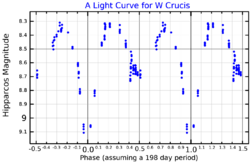Astronomy:W Crucis
| Observation data Equinox J2000.0]] (ICRS) | |
|---|---|
| Constellation | Crux |
| Right ascension | 12h 11m 59.16182s[2] |
| Declination | −58° 47′ 00.7374″[2] |
| Apparent magnitude (V) | 8.18(-8.50)-9.01[3] |
| Characteristics | |
| Spectral type | F8/G1Ia/abe[4] (B + G1Iab)[5] |
| Variable type | Algol[6] |
| Astrometry | |
| Radial velocity (Rv) | −22.6±2[7] km/s |
| Proper motion (μ) | RA: −6.142[2] mas/yr Dec.: 0.198[2] mas/yr |
| Parallax (π) | 0.5363 ± 0.0421[2] mas |
| Distance | 6,100 ± 500 ly (1,900 ± 100 pc) |
| Orbit[5] | |
| Period (P) | 198.5 days |
| Semi-major axis (a) | 306 R☉ |
| Inclination (i) | 88.2° |
| Details | |
| Luminosity | 1,928[2] L☉ |
| A | |
| Mass | 8.2[5] M☉ |
| Radius | 71[5] R☉ |
| Temperature | 14,000[8] K |
| B | |
| Mass | 1.6[5] M☉ |
| Radius | 4[5][8] R☉ |
| Temperature | 5,500[8] K |
| Other designations | |
| Database references | |
| SIMBAD | data |
W Crucis is a single-lined eclipsing variable star system in the constellation Crux. It has a spectral class of F8/G1Ia/abe indicating a yellow supergiant with emission lines in its spectrum.
W Crucis varies in brightness between magnitude 8.18 and 9.01 over a period of 198.5 days. Its light curve has been observed to be asymmetric with subsequent maxima differing in height, which is described as the so-called O'Connell effect.[10] A secondary minimum is observed when the brightness drops to magnitude 8.5. The shape and duration of the eclipses show that the two stars are detached and that there is an accretion disk around the primary, more massive, star.[5]
Spectral lines can only be seen for one of the stars, a yellow supergiant. The other, more massive, star is hidden within an accretion disk of material stripped from the supergiant. The hidden star has properties that suggest it is a mid-B main sequence star. The two are separated by 306 R☉, about 1.4 astronomical unit|AU. The hot main sequence star has a mass of 8.2 M☉, while the supergiant only has a mass of 1.6 M☉. The supergiant is deformed by the gravity of the more massive primary star, fills its Roche lobe, and is losing mass.[5]
The disk around the hot star is 124 R☉ wide and 17 R☉ thick, with a temperature at its outer visible edge of 3600 K. It is the source of the emission lines seen in the spectrum.[5]
References
- ↑ "Hipparcos Tools Interactive Data Access". ESA. https://www.cosmos.esa.int/web/hipparcos/interactive-data-access.
- ↑ 2.0 2.1 2.2 2.3 2.4 2.5 Brown, A. G. A. (August 2018). "Gaia Data Release 2: Summary of the contents and survey properties". Astronomy & Astrophysics 616: A1. doi:10.1051/0004-6361/201833051. Bibcode: 2018A&A...616A...1G. Gaia DR2 record for this source at VizieR.
- ↑ Avvakumova, E. A.; Malkov, O. Yu.; Kniazev, A. Yu. (2013). "Eclipsing variables: Catalogue and classification". Astronomische Nachrichten 334 (8): 860. doi:10.1002/asna.201311942. Bibcode: 2013AN....334..860A.
- ↑ Houk, N.; Cowley, A. P. (1975). University of Michigan Catalogue of two-dimensional spectral types for the HD stars. Volume I. Declinations -90_ to -53_ƒ0. Bibcode: 1975mcts.book.....H.
- ↑ 5.0 5.1 5.2 5.3 5.4 5.5 5.6 5.7 5.8 Pavlovski, K.; Burki, G.; Mimica, P. (2006). "Indirect imaging of an accretion disk rim in the long-period interacting binary W Crucis". Astronomy & Astrophysics 454 (3): 855–862. doi:10.1051/0004-6361:20054733. Bibcode: 2006A&A...454..855P.
- ↑ Samus, N. N. et al. (2009). "VizieR Online Data Catalog: General Catalogue of Variable Stars (Samus+ 2007-2013)". VizieR On-line Data Catalog: B/GCVS. Originally Published in: 2009yCat....102025S 1: B/gcvs. Bibcode: 2009yCat....102025S.
- ↑ Evans, D. S. (June 20–24, 1966), "The Revision of the General Catalogue of Radial Velocities", in Batten, Alan Henry; Heard, John Frederick, Determination of Radial Velocities and their Applications, Proceedings from IAU Symposium no. 30, 30, University of Toronto: International Astronomical Union, p. 57, Bibcode: 1967IAUS...30...57E.
- ↑ 8.0 8.1 8.2 Zola, S. (1996). "W Crucis: An eclipsing binary system containing an accretion disk". Astronomy and Astrophysics 308: 785. Bibcode: 1996A&A...308..785Z.
- ↑ "W Crucis". SIMBAD Astronomical Database. Centre de Données astronomiques de Strasbourg. http://simbad.u-strasbg.fr/simbad/sim-id?Ident=W+Cru&NbIdent=1&Radius=2&Radius.unit=arcmin&submit=submit+id. Retrieved 23 June 2014.
- ↑ D. J. K. O'Connell (1951). "The so-called periastron effect in close eclipsing binaries". Riverview College Observatory Publications 2 (6): 85. Bibcode: 1951PRCO....2...85O.
 |


